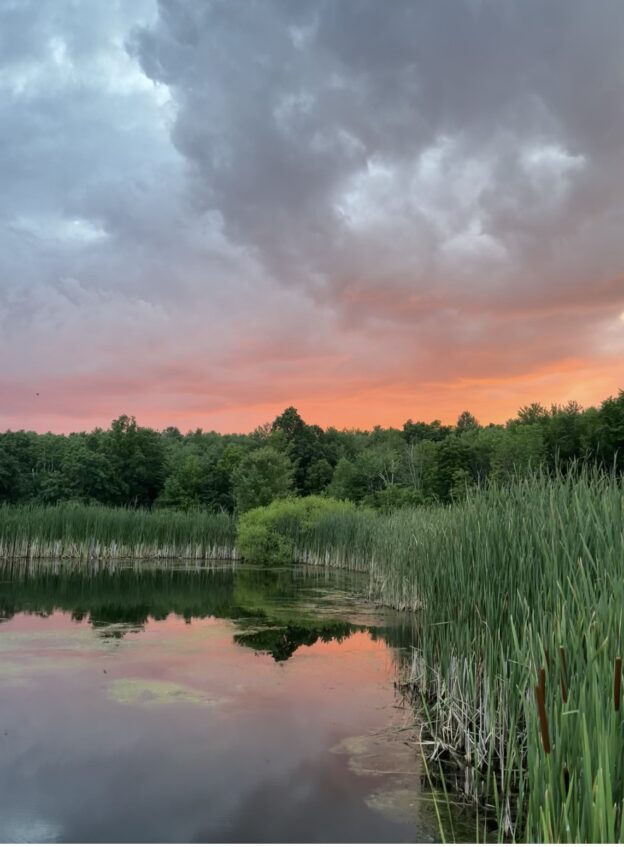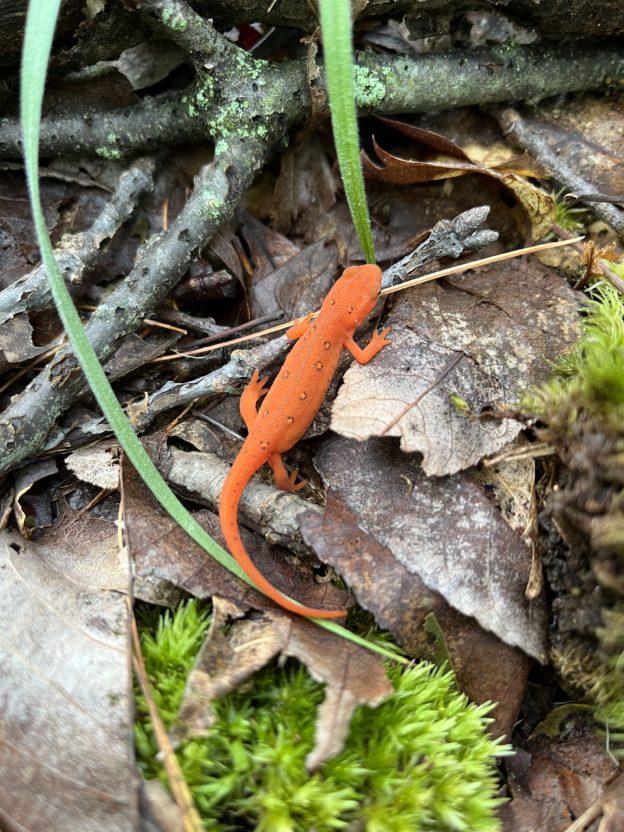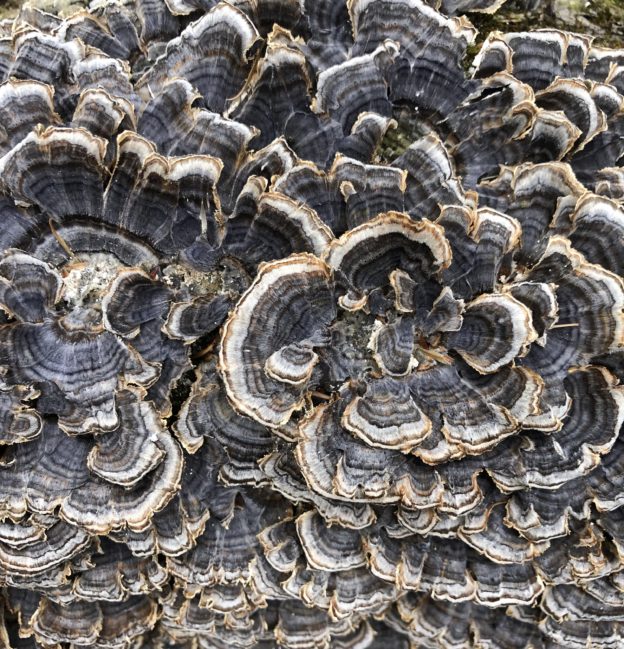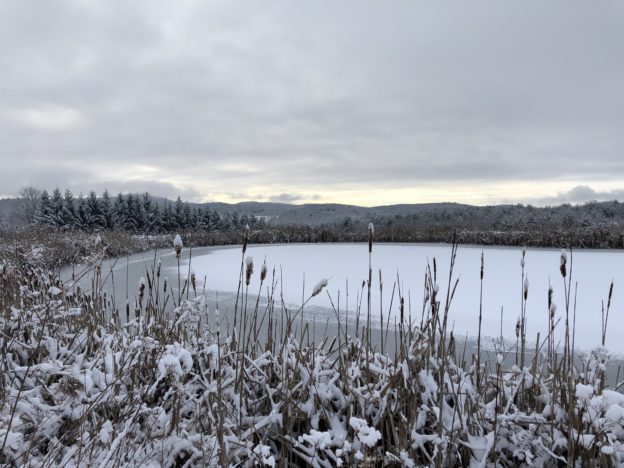Red Efts and Other Wonders

It’s unsettling to carry on with daily rituals and activities while Israel’s genocidal assault on Gaza rages on. Each morning, I check to see what horror unfolded while I was asleep, looking for mentions of the areas where my mentees and their families are sheltering. Each day I communicate with Haya, Sahar, and Nadera about their various writing and educational projects. I continue my involvement with Writers Against the War on Gaza, and use my social media platforms to amplify the reports coming out of Gaza and the West Bank. None of it feels like enough. To keep myself from an unending cycle of despair, anxiety, and rage, I have been spending time in the woods and the meadow as a kind of walking meditation.
The other morning after a night of pouring rain, I went for a walk on the trails behind our house. There were so many Red Efts on the path, that I had to watch my feet so I wouldn’t step on them. I started counting them as I walked, and quickly reached two dozen. I have been fascinated with these creatures since I was in sixth grade and a boy in our class brought in a terrarium with three that he was keeping as pets.
I think of the Red Eft as the teenager form of the Eastern Newt, which is a type of salamander that lives in this region. When they first hatch in the vernal pond, they are aquatic larvae or tadpoles that breathe underwater. In their next phase, they become Red Efts, which are orange with two rows of red dots circled in black down their backs. At this point, they are terrestrial and breathe air. After two to three years, they change again to their final adult aquatic form, when their coloration shifts to a dull olive green back with a yellow belly. But they still have the black-rimmed spots. An Eastern Newt can live in the wild for up to eight or ten years but have been recorded to live to fifteen.
I’ve also been watching the Ruby-Throated Hummingbirds at the feeder outside my study window. They fly circuits around the yard, sipping nectar from flowers and the feeder.
The only hummingbirds found in the northeastern United States, they are very territorial, and there are lots of buzzy altercations. The adult male has the eponymous iridescent red throat, and its tail feathers are pointed and dark. The adult female and juvenile male and female have white throats and white tips on the outer tail feathers.
Recently, I have also seen twin White-Tailed Deer fawns grazing in the meadow behind the house, their mother always within a few yards. Several years ago, Djuna and I were walking in the woods when we wandered off the trail and discovered a days-old fawn sleeping in a hollow under a fallen tree. Luckily, I had learned that it was fine for a fawn to be left alone for up to twelve hours at a time while its mother foraged for food. In fact, it was safer for a newborn like this to stay on its own because it blended into the forest and hadn’t yet developed an odor that would attract predators. When White-Tailed Deer fawns are born, they have white spots on their sides. These spots disappear when they are between three to six months old and grow in their winter coats. In our area, the spots are generally gone by October.
It’s been raining all week, and the other day during a blustery downpour, I looked out the bedroom window to see two dozen House Finches perched under the eaves of our front porch. That made me wonder what all the other birds were doing in the foul weather brought to our region by Hurricane Debbie. Birds that nest in cavities, such as Chickadees, can take shelter there. Birds that roost on branches, such as Blue Jays, perch on a thick branch next to the tree’s trunk during a storm.
What’s the difference between a frog and a toad? Frogs have smooth, damp skin and toads have dry, bumpy skin. Frogs have longer legs made for jumping and swimming. Toads tend to have shorter legs. Frogs tend to live near a body of water because they need to keep their skin moist, but toads can be found in the forest. Tree frogs need to be near water, but they aren’t great swimmers.
How can you tell the difference between a butterfly and a moth? Butterflies have smooth, club-like antennae and moths have feathered or branched antennae with no rounded club shape at the end. We generally think of butterflies as having large, brightly colored wings, but Skippers are a group of small, chunky butterflies, and several species are drab gray or brown.
And now on a few other topics…
My friends at the International Armenian Literary Alliance (IALA) posted about the upcoming publication of my novel THE BURNING HEART OF THE WORLD. If you pre-order the book through this link, IALA receives a small portion of the proceeds.
For Tempest Magazine, our daughter Djuna wrote a clear-eyed and disturbing piece about Israel’s use of artificial intelligence to generate “kill lists” in Gaza.
My new We Are Not Numbers Mentee (WANN) Nadera wrote a poem called “The Child and the Olive Tree.” My former WANN mentee Hossam managed to evacuate to Cairo a few months ago, but he and his siblings are now in need of financial support because they can’t get work permits in Egypt.
Thanks for reading. Ceasefire now.
Nancy Kricorian
August 10, 2024








